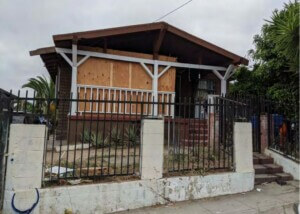It’s no TARDIS, but the Prairie Grove, Arkansas, Airlight telephone booth, on U.S. 62 in front of the Colonial Motel, has defied cell phones and a near fatal encounter with a runaway SUV to become the first phone booth listed on the National Register of Historic Places.
Built in 1959, this metal-and-glass Airlight booth was nominated in April by the Arkansas Historic Preservation Program. On November 9th, the National Park Service (NPS) accepted the Airlight into its pantheon of historic structures.
Initially, the NPS had hesitations about the nomination. Arkansas Online reports that the National Register/survey coordinator for the Arkansas Historic Preservation Program, Ralph Wilcox, received a letter from the National Register stating that the “‘listing blurs the line between a ‘place’ and an artifact, and it begs the questions about where the line between significance and nostalgia is drawn.'”
Wilcox emphatically disagreed, and re-submitted a nomination that emphasized the Airlight’s distinctive historical characteristics. Prior to the development of the Airlight in 1954, Wilcox explained, phone booths were mostly made of wood and installed indoors. Developed for Bell Telephone System, the Airlight is the first telephone booth in the United States designed especially for the outdoors. The phone booth was intended to serve motorists traveling on the adjacent highway.
Wilcox’s response has precedent among progressive voices in the critical establishment. Almost a decade ago, BLDGBLOG founder Geoff Manaugh called for a democratization of the definition of architecture in a jeremiad on old school, Adorno-laden architectural criticism. To Manaugh, (some) architecture criticism repels potential readers because critics disdain the vernacular, the architecture of everyday space that most people experience:
Temporary Air Force bases, oil derricks, secret prisons, multi-story car parks, J.G. Ballard novels, Robocop, installation art, China Miéville, Department of Energy waste entombment sites in the mountains of southwest Nevada, Roden Crater, abandoned subway stations, Manhattan valve chambers, helicopter refueling platforms on artificial islands in the South China Sea, emergency space shuttle landing strips, particle accelerators, lunar bases, Antarctic research stations, Cape Canaveral, day-care centers on the fringes of Poughkeepsie, King of Prussia shopping malls, chippies, Fat Burger stands, Ghostbusters, mega-slums, Taco Bell, Salt Lake City multiplexes, Osakan monorail hubs, weather-research masts on the banks of the Yukon, Hadrian’s Wall, Die Hard, Charlie and the Chocolate Factory, Warren Ellis, Grant Morrison, Akira, Franz Kafka, Gormenghast, San Diego’s exurban archipelago of bad rancho housing, Denver sprawl, James Bond films, even, yes, Home Depot – not every one of those is a building, but they are all related to architecture.
The register divides important sites into five typologies: buildings, districts, sites, structures, and “large objects.” The National Register has not shied away from kitschy or unusual listings in the latter category.
In August 2002, the NPS granted a register spot to the World’s Largest Catsup Bottle in Collinsville, Illinois. The 70-foot-tall condiment container has a capacity of 100,000 gallons and was built in 1949 for the Brooks (rich and tangy!) catsup company. Generally, properties have to be at least 50 years old to be listed on the National Register.
According to David Parks, president of Prairie Grove Telephone Company, there are no plans to add an official marker to the site. The telephone company has thought about removing the phone booth, but keeps it standing for nostalgic purposes. It’s a revenue generator, besides: the coin box yields three to four dollars in change per year.










